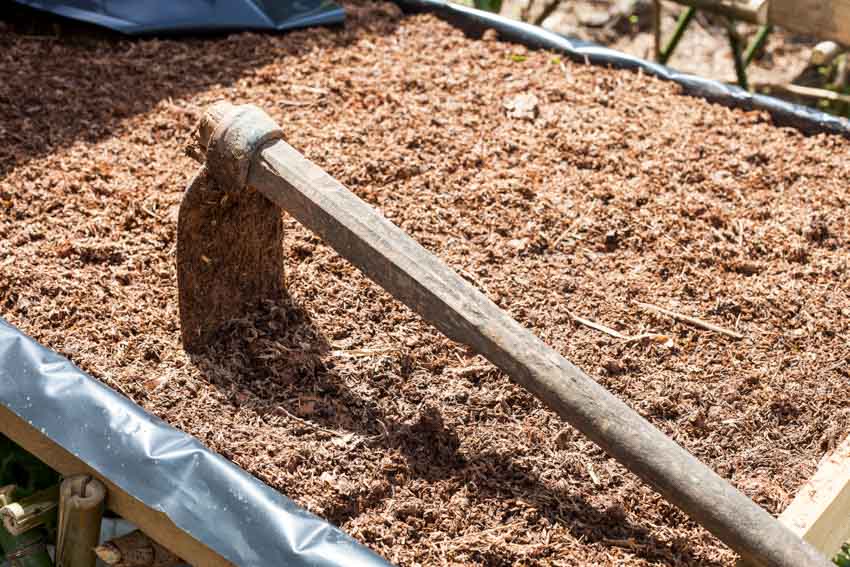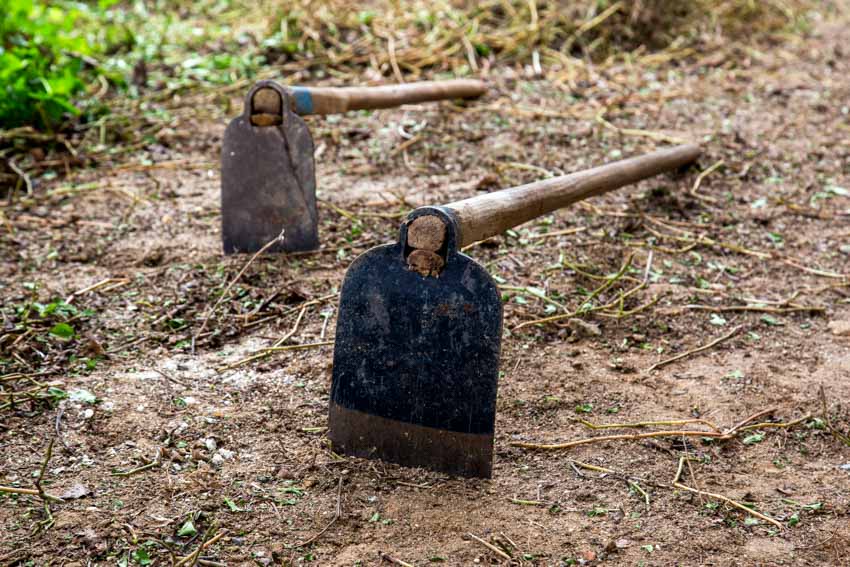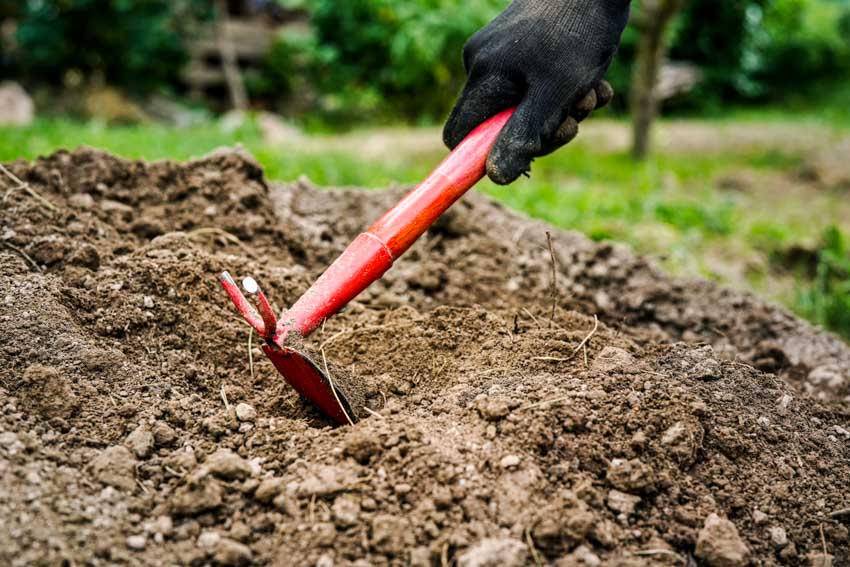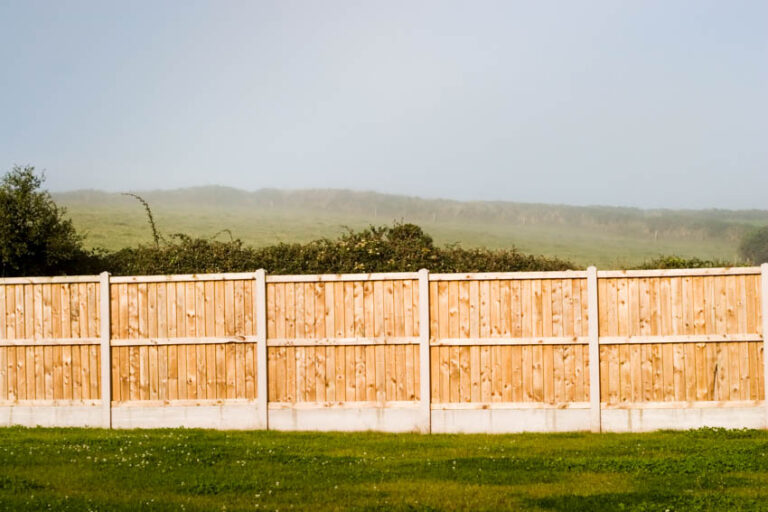19 Types Of Garden Hoes (Designs & Uses)
If you’re working outside in your garden, grabbing the right tool for the job can make the difference between a quick job and hard, exhausting work. Even if you know you need a garden hoe, there’s a bit more to it than that. There are many different types of garden hoes out there and each one has its own unique purpose and design to fit that.
Draw Hoes
Draw hoes are what most people picture when they think of a garden hoe. You might also hear these referred to as chopping, planter, or even paddle hoes. These have a rather simple design including a long handle ending in a head with a wide blade. When you pick it up, you’ll notice a draw hoe is rather lightweight.
These are most often used on the surface of the ground rather than digging deeper into it. They can help you most when you notice the soil in your garden is starting to clump up.
You can use this hoe to help break these clumps apart. It’s also rather useful for loosening weeds, hilling potatoes, or shaping the soil in your garden bed.
As the name suggests, you use this model by putting the head where you need it and pulling the hoe back towards yourself. This is known as a pull-motion design. As such, this function makes it a staple among garden types of sheds.
Field Hoes
While draw hoes are useful in loosening some weeds in your garden, if you want to really tackle weeds, you’re better off opting for a field hoe. These types are like draw hoes but are built to withstand even tougher jobs, making them perfect for tangled weeds.
Much like a draw hoe, they usually have a long handle and a wide head. The head of a field hoe, though, features a strong blade that can cut deeper into the ground, helping tug organic material towards you after you dig into the ground. For the best results, make sure you apply your blade to the soil at a 45-degree angle.
The head of these doesn’t just offer one sharp side to their blades. They have three distinctly sharp sides, helping them dig into the soil and tear through weeds more efficiently.
Scuffle Hoes

Scuffle hoes actually work just below the surface of the soil. This is because they’re made to help you weed areas quickly and break up the soil. To do this, they rely on a wide blade with sharp edges. You can control how deeply you cut into the soil based on the angle and force you use.
To get rid of weeds at the surface and loosen up the soil, you’ll want to keep things shallow. On the other hand, if you want to get rid of problems like weeds at their root, a scuffle design can work deep enough to cut through the roots. To accomplish this, you’ll want to dig the blade in at least ¼” to ½” deep into the soil.
Since these types are used to help sever root systems, it’s especially important to make sure that you keep your scuffle hoe sharp to keep it performing at its best.
Warren Hoes (Dutch)
This type of garden hoe goes by a few different names. This includes the names Warren as well as Dutch. They come in a few different varieties. While they all have a long handle so you can use them from a standing position but the head of the hoe can either be shaped like a triangle or even a heart. No matter which shape the head has, it’s always positioned at a 90-degree angle from the handle.
There are a couple of handy uses for Warren hoes. The shape of the head is helpful for digging trenches. This is handy when you’re getting ready for the season and laying rows of seeds in your garden.
This is one of the easiest garden tools to use and is useful for harvesting vegetables, cultivation, and digging around flowers. While not quite as effective as a scuffle hoe at completely removing weeds, Warren models are also handy for pulling up young weeds while you prepare your garden.
Wheel Hoe
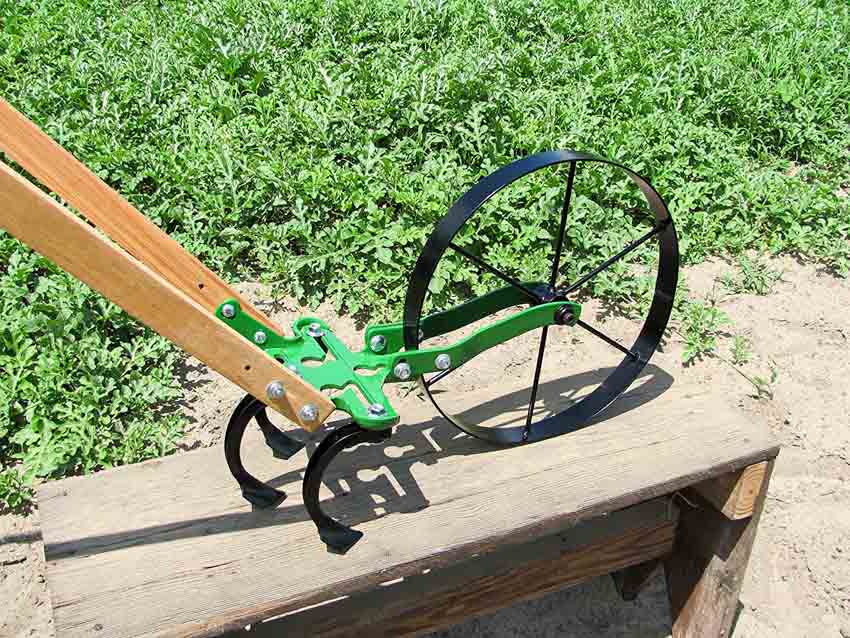
A lot of hoes require you to really put your back into it to see results. There are times that opting for a push-operated tool can save you some effort compared to a pull-operated one. Wheel hoes are designed to take most of the work on for you. These are great for loosening up your soil, hilling your crops, and even leveling your garden as well.
As the name suggests, these have a wheel in front of the blades themselves. This makes it much easier for you to push the tool along and you don’t even have to worry about putting in as much effort to complete the job.
Most household models feature one wheel but larger models can sport multiple wheels. Alongside the added mobility, these designs are kept lightweight to make them even easier to push along as you work in your garden.
Eye Hoes
Eye and grub hoes are two types that are often confused but they actually have distinct differences. An eye hoe is a sturdy choice and it’s a classic one too – this is one of the oldest pieces of this type of gardening equipment you can choose. Yet, the design has remained popular for its efficiency and it’s not uncommon to have one hanging out in the shed.
An eye hoe is best used to break up tough clumps of weed or grass. To attack weeds where they stand, you can pull one through your garden to help catch and pull up weeds. This makes this type a draw or pull model, so you’ll dig into the soil and pull the tool back towards yourself to make the changes you’re going for.
Grub Hoes
As we mentioned, grub hoes are often confused with eye hoes. Yet, they don’t serve the same purpose. Whereas an eye style is a type of draw hoe, grub hoes are more targeted at digging. To accomplish this, they’re designed as a type that you dig into the soil at a 45-degree angle and pull towards you to operate. In fact, they are another model that have become fairly common around the home.
These types don’t usually have an incredibly wide head. Instead, they focus on a blade with a narrower edge than a choice such as a field hoe.
Paired with a strong shaft that will stand up to repeated use, these products can weigh up to five pounds but you can find options as light as two pounds. Grub hoes aren’t made to stand up to rocky soil and they’re better used in flat areas like garden beds over more hilly areas.
Heart-Shaped Hoes
As the name suggests, a heart-shaped hoe gets its name from the heart-shaped head it sports. While it might not look like a Valentine’s Day card, these designs have a blade that looks like a heart with more angled edges. In most cases, the blades are made with carbon steel while the heavy-duty handle is thick wood that will hold up over time.
They need to be sturdy too! They’re designed to help you loosen up tightly compacted soil and break up the ground but they’re handy for weeds in tight spots too.
The push-and-pull method of operation is also a bit easier on your back during extended use. You also don’t have to heave this model into the ground but rather push and pull it while the blade itself stays flat. You’ll want to keep it sharp to keep it operating at its best, though.
Ridging Hoes
We’ve already seen that some types of garden hoes go by two names. In other words, you might hear a few different names all referring to the same tool. This is true for ridging hoes.
“Ridging” is just another term for warren hoes. So, you can expect the same spade-shaped head protruding from a long handle to be used as a push hoe while you’re standing, so don’t try to pull on these because it won’t be as effective.
They’re great for a few key purposes including digging small trenches and getting ready to plant your seeds or bulbs. These types are also great for edging and extracting new weeds that haven’t reached maturity yet.
Diamond Hoes
Diamond hoes are interesting because the head is shaped like a diamond with a blade on each side. As a result, you can use it for a variety of applications, including getting rid of weeds or tilling grass and dirt. Usually, these blades are about 5 ¾” wide.
Much like a heart-shaped design, a diamond hoe is best pushed along the ground while it’s flat. Again, to make sure you have the same results each time, you’ll want to make sure you keep the blades sharp as they’ll naturally dull quickly as you push and pull them around your garden.
This operation method helps to reduce the strain on your back when you use this type since it doesn’t take as much physical effort on your part as a model you need to dig into the ground and pull back.
Stirrup Hoes

A stirrup hoe is a type that falls into the larger category of reciprocating hoes. This means that it’s another model you use by pushing and pulling rather than just digging and pulling. They’re handy in a few ways whether you want to aerate the soil or to pull and gather weeds. You can use it to gather loose weeds in your garden too.
Stirrup hoes get their name from their appearance. Instead of a flat blade, these end in a looped blade shaped a lot like the stirrup you’d step into on a saddle. This shape is great for scooping through the soil without excessively displacing it. In addition, the head of this type is narrow enough to help you work in tough spots like between rows in your garden bed.
To use this, you’ll want to dig into the soil but only at a shallow two to 15-degree angle. This will help get just beneath the surface of the soil without disturbing your garden too much.
Action Hoes

Action hoes are another type of reciprocating tool that you can move back in forth. Paired with a long handle, this makes these types easy to use without too much strain on your back. These are very similar to a stirrup hoe as they rely on the same shape to help you work through your garden.
Much like a stirrup design, these are great for working through the soil without moving it around more than necessary. This makes it a useful tool if you need to carefully work around live plants to remove weeds but it’s excellent for helping your prepare your garden beds for planting as well.
All you have to do to operate this type is to scrub it back and forth over the area you’re trying to rid of weeds. With a long handle and reciprocating design, these tools help reduce the strain on your upper body as you work. However, products are also available in handheld versions for smaller gardens too.
Swage Hoes

Another useful garden tool is a swage hoes, although you may hear these tools called Ploskorez hoes too. These are also popular among homeowners for a few reasons.
One of the biggest reasons is how versatile this type is. These are employed for the use of tackling weeds, shaping your cultivated plants, preparing the soil, mixing the appropriate types of compost or fertilizer, and more. The narrow design is especially helpful for reaching tight areas in your garden that most hoes are a bit wide for.
Once again, you have a bit of versatility here in design too. Swage varieties are available in a few different forms, including larger models you’d use from a standing position as well as smaller, handheld models. Either way, they still offer all of the same variety of uses.
Trapezoid Hoes
Unsurprisingly, trapezoid hoes are named for the trapezoid-shaped heads that they sport. These come in a variety of sizes to suit your needs but you’ll notice the widest part of the trapezoid is always the usable blade.
If you have a smaller garden, you can opt for a smaller model to fit your needs and give you more control while a larger model can move through more land at a quicker pace. You can sharpen the blade over time but you can typically replace the blade as well.
These are often used for weed removal, especially maturing or fully-established weeds. You can use the wide head to scrape up weeds.
To do this, trapezoid styles rely on a pull-action design. However, if you find you need something a little easier to cut through weeds with, the sharp corners of the trapezoid design work well here.
Swan Neck Hoes

A swan neck hoe is a type known as a light draw. These are meant to be easy to use in how lightweight they are. They’re much easier to operate and since they aren’t as heavy, they offer some versatility in how you can comfortably grip them.
Swan neck styles are sometimes called half-moon hoes. They feature a wide blade with sharp edges connected to the handle by a curved piece of metal. The handle is often made out of wood or while a carbon steelhead is a popular choice for the blade.
These types are used for pulling weeds and breaking up soil. Much like a trapezoid design, swan necks have sharp corners that are great for tearing through weeds.
Hand Plows
Hand plows are almost exclusively made for use by hand. As such, they have a short handle that you can use without being stuck in a standing position although some models do offer a longer handle.
Yet, that isn’t the only thing these hand plows do for comfort. They often have an ergonomic handle made to be easy to hold while also offering a balanced design. This way, you can cut down on how fatiguing it is to work through your garden.
This type uses a pull design to operate. You can use it to help break up the soil when you’re getting your garden ready for the season or you can use it to help you plant bulbs.
In maintaining your garden throughout the season, it’s a handy tool to have around for weeds too. Furthermore, it can be easily stored using most types of pegboard hooks.
Fork Hoe
Fork hoes go by a few different names as well. You might hear them referred to as bent forks, or even prong hoes. These look a lot like a pitchfork but with the end bent down towards the ground in the traditional shape. This forked blade will have at least two tines.
It’s a useful tool to have around when you’re trying to get your garden ready for the new season and their specialties do lie with pre-season preparation.
Specifically, it’s a great tool to have when you’re breaking up the soil and the tines are great for digging into the soil and tearing it apart when you pull the hoe back toward you.
Hand Fork
A hand fork is pretty much the same concept as a fork hoe. However, the term directly refers to the handheld version of the tool, making it great for small gardens and tight spaces. Given this design, hand forks tend to have a shorter more ergonomic handle to help reduce fatigue as you work.
These are great for pulling up small weeds and you might hear them called “weeding forks” as an alternate name. To add to that, you can also use a hand fork for mixing your soil, transplanting live plants, and helping prepare planting holes at the beginning of the season.
Collinear Hoes
Collinear hoes are a type of sweeping tool. This means when you use it, you’ll want to swing it back and forth along the area you’re going over. This is often best done to your side and you’ll see the most precision when you look down the handle, straight towards the blade.
These types are most often used while standing and they sport a thin but still sharp blade. The idea here is that the blade will easily cut through the top of the soil and the weeds in its way at their root, making it incredibly efficient and the results lasting.
Its precision is impressive enough that you can use it around live plants without harming them in the process. For more like this see our article about the types of rakes.
How To Choose The Best Garden Hoe
There are a few things you’ll want to consider when you’re buying a garden hoe. One of the most obvious is purpose. As we’ve seen here, there are many different designs for many different uses, and choosing the right one for the job is crucial! Varying tools have different head sizes and shapes to account for different jobs.
From there, you’ll also want to pay attention to the comfort of use. Can you hold and use the length of the hoe comfortably? Does the model you’re considering have any ergonomic design features?
Since you’re using this tool for manual labor, it’s essential to make sure you a hoe you can handle it without a problem or you’ll find yourself more sore than necessary at the end of your job. This can also refer to whether it uses pull-motion or push-motion to operate. If you can’t decide, some options can do both.
What’s your go-to types of gardening hoe? Share the kinds you can’t go without or let us know if we left anything out in the comments. See more related content in our article about the best shed organization ideas on this page.

